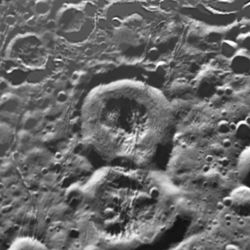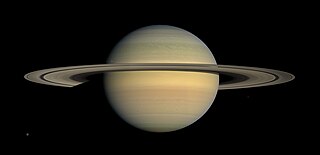
Enceladus is the sixth-largest moon of Saturn. It is about 500 kilometers (310 mi) in diameter, about a tenth of that of Saturn's largest moon, Titan. Enceladus is mostly covered by fresh, clean ice, making it one of the most reflective bodies of the Solar System. Consequently, its surface temperature at noon only reaches −198 °C (−324 °F), far colder than a light-absorbing body would be. Despite its small size, Enceladus has a wide range of surface features, ranging from old, heavily cratered regions to young, tectonically deformed terrains.
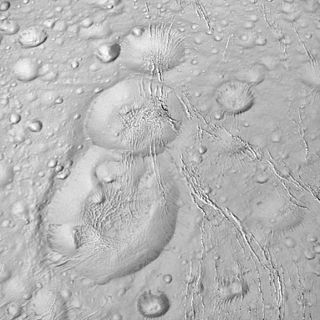
Dunyazad is a large crater on Saturn's moon Enceladus first discovered by the Voyager 2 spacecraft. It is named after Dunyazad, the sister of Scheherazade in The Book of One Thousand and One Nights.

Shahrazad is a large crater on Saturn's moon Enceladus first discovered by the Voyager 2 spacecraft. It is located at 47.3° North Latitude, 199.7° West Longitude and is approximately 20 kilometers across. Shahrazad is the middle crater of a prominent crater triplet on Enceladus' anti-Saturnian hemisphere. Voyager images revealed very little about this crater, however, higher resolution views of Shahrazad taken by the Cassini Spacecraft during a close flyby on March 9, 2005 reveal significant north-south fracturing that runs through all three craters of the triplet. Deep canyons mark the northern and eastern portions of Shahrazad's rim. Some evidence for viscous relaxation can be seen, but it is not nearly as significant as at Dunyazad to its immediate south or at Aladdin elsewhere on the satellite.
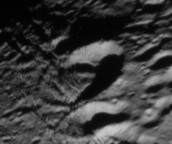
Ahmad is a crater in the northern hemisphere of Saturn's moon Enceladus. Ahmad was first discovered in Voyager 2 images but was seen at much higher resolution, though near the terminator, by Cassini. It is located at 58.8° North Latitude, 311.6° West Longitude and is 18.7 kilometers across. The western portion of the crater is largely absent, either buried or disrupted by the eastern margin of Samarkand Sulci. A large, dome-like structure occupies the interior of the crater, caused by infill of material from Samarkand Sulci or from viscous relaxation.

Peri-Banu is a crater in the northern hemisphere of Saturn's moon Enceladus. Peri-Banu was first discovered in Voyager 2 images but was seen at much higher resolution, though near the terminator, by Cassini. It is located at 62° North Latitude, 322.9° West Longitude and is 18 kilometers across. The western portion of the crater is largely absent, either buried or disrupted by the eastern margin of Samarkand Sulci. A large, dome-like structure occupies the interior of the crater, caused by infill of material from Samarkand Sulci or from viscous relaxation.
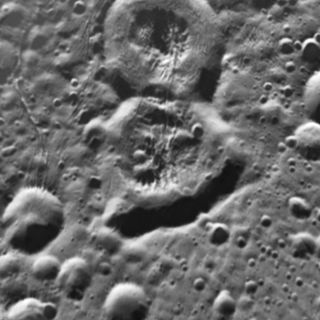
Ali Baba is a large crater in the northern hemisphere of Saturn's moon Enceladus. Ali Baba was first discovered in Voyager 2 images. It is located at 55.1° North Latitude, 22.3° West Longitude and is 39.2 kilometers across. It is located near the craters Aladdin and Samad. Ali Baba has a large dome in its interior, suggesting the crater has undergone viscous relaxation. The top of the dome even reaches higher than the crater rim.
Salih is a small crater near the sub-Saturnian point of Saturn's moon Enceladus. Salih was first discovered in images taken by the Voyager 2 spacecraft. It is located at 6.5° South Latitude, 0° West Longitude and is 4 kilometers across. Available images of this crater have too low resolution to determine anything about the geology of this crater.

Samad is a crater in the northern hemisphere of Saturn's geologically active moon Enceladus. Samad was first discovered in Voyager 2 images. It is located at 60.3° North Latitude, 4.5° West Longitude and is 16.3 kilometres (10.1 mi) across. Currently available images are too low in resolution to determine if this crater has been tectonically deformed, but the lack of a prominent central dome suggests Samad has not undergone the level of viscous relaxation of other craters in its size range, like Dalilah or Ahmad. Samad is located near the larger craters Aladdin and Ali Baba.
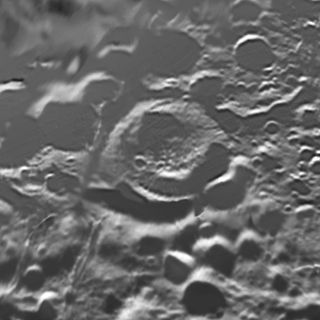
Musa is a crater in the northern hemisphere of Saturn's moon Enceladus. Musa was first seen in Voyager 2 images. It is located at 72.4° North Latitude, 17.6° West Longitude and is 25 kilometers across. Musa is located North of Aladdin. A large, dome-like structure occupies the interior of the crater, suggesting the crater has undergone significant viscous relaxation. From Voyager 2 images, it also appears that Musa is superimposed on an older crater that formed just to the south.
Gharib is a crater near the north pole of Saturn's moon Enceladus. Gharib was first seen in Voyager 2 images. It is located at 81.1° North Latitude, 241.2° West Longitude and is 26 kilometers across. A large, dome-like structure occupies the interior of the crater, suggesting the crater has undergone significant viscous relaxation.

Shahryar is a crater in the northern hemisphere of Saturn's moon Enceladus. Shahryar was first seen in Voyager 2 images, but was seen at much higher resolution by the Cassini spacecraft. It is located at 58.3° North Latitude, 227.5° West Longitude and is 24 kilometres (15 mi) across. Despite being nearly the same size as the nearby Sindbad crater, Shahryar does not exhibit a dome-like structure on its floor, suggesting it has not undergone significant viscous relaxation. In addition, there is very little evidence that it has experienced tectonic deformation, suggesting that Shahryar is a relatively young crater.
Sindbad is a crater in the northern hemisphere of Saturn's moon Enceladus. Sindbad was first seen in Voyager 2 images, though the southern rim has been seen by Cassini. It is located at 67° North Latitude, 212° West Longitude and is 29.1 kilometers across. A large, dome-like structure occupies the interior of the crater, suggesting the crater has undergone significant viscous relaxation.

Bassorah Fossa is a trough south of Ali Baba crater on Saturn's moon Enceladus. Bassorah Fossa was first seen in Voyager 2 images. It is located at 45.4° north, 6.3° west, and is 131 kilometers long.

Al-Haddar is an impact crater on Saturn's moon Enceladus, first discovered by the Voyager spacecraft. It is named after Al-Haddar, one of the barber's six brothers in "The Hunchback's Tale" from The Book of One Thousand and One Nights.

Sharrkan is an impact crater in the northern hemisphere of Saturn's moon Enceladus. Sharrkan was first observed in Cassini images during that mission's February 2005 flyby of Enceladus. It is located at 16.4° North Latitude, 298.3° West Longitude. At only 3.6 kilometers across, Sharrkan is the smallest named crater on Enceladus, though numerous, smaller, unnamed craters have been observed. The crater has a basic bowl-shape typical of small, simple craters.

Shakashik is an impact crater on the anti-Saturn hemisphere of Saturn's moon Enceladus. Shakashik was first observed in Cassini images during that mission's March 2005 flyby of Enceladus. It is located at 17.3° South Latitude, 180.8° West Longitude, and is 8.5 kilometers across. Behram appears to have formed after Shakashik, based on the superposition of the larger crater's southern rim on Shakashik's northern rim. Following the formation of Behram, north-south trending fractures cut across both craters, forming several canyons within the western half of Shakashik.

Zumurrud is a large impact crater on the anti-Saturn hemisphere of Saturn's moon Enceladus. Zumurrud was first observed in Cassini images during that mission's March 2005 flyby of Enceladus. It is located at 21.9° South Latitude, 181.6° West Longitude, and is 21 kilometers across. Images taken by Cassini during its March and July 2005 flybys of Enceladus revealed a great deal about the geology of this impact crater. Since formation, Zumurrud has been modified by viscous relaxation, tectonic fracturing along the crater's rim, forming canyons hundreds of meters deep, and subsequent cratering, like the small crater along Zumurrud's western rim. In addition, brightness variations can be seen along the eastern crater wall, suggesting variations in water ice grain size.

Otbah is an impact crater on the southern hemisphere of Saturn's moon Enceladus. Otbah was first observed in Cassini images during that mission's March 2005 flyby of Enceladus. It is located at 39.8° South Latitude, 159.5° West Longitude, and is 9.4 kilometers across. A smaller impact occurred after the Otbah impact on the larger crater's southern rim, forming an impact crater 3 kilometers across. In addition to subsequent cratering, southwest-northeast trending fractures, prevalent in this region of Enceladus, cut across Otbah, forming several canyons several hundred meters deep along Otbah's rim. The high level of tectonic activity associated with this fracturing and the formation of the nearby south polar terrain may have also led to mass wasting along the crater's wall, leading to a 3 kilometer wide landslide deposit in the center of Otbah.
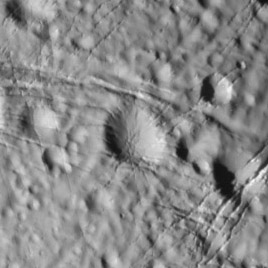
Rayya is an impact crater on the southern hemisphere of Saturn's moon Enceladus. Rayya was first observed in Cassini images during that mission's March 2005 flyby of Enceladus. It is located at 32.5° South Latitude, 178.4° West Longitude, and is 9 kilometers across. Cassini observed numerous criss-crossing sets of fractures cutting across Rayya, forming canyons several hundred meters deep along the crater's rim.

Al-Mustazi is an impact crater located on the anti-Saturn hemisphere of Saturn's moon Enceladus. Al-Mustazi was first observed in Cassini images during that mission's March 2005 flyby of Enceladus. It is located at 20.9° South Latitude, 202.0° West Longitude, and is 10.3 kilometers across. Cassini observed numerous southwest-northeast trending fractures cutting across the southwest rim of Al-Mustazi, forming canyons several hundred meters deep. These fractures were deflected by the weakened regolith produced by the Al-Mustazi impact. This deflection produced the pattern of radiating fractures seen along the northeastern rim of Al-Mustazi.
